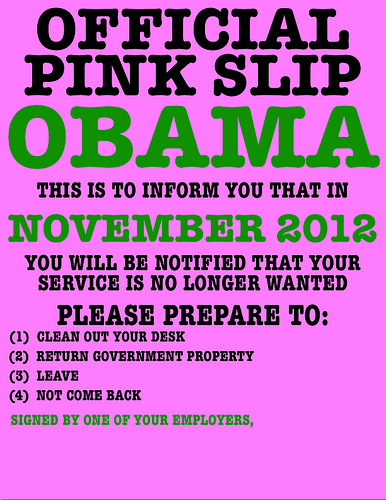I’ve commented on the failure of Obamanomics, with special focus on how both banks and corporations are sitting on money because the investment climate is so grim. Not exactly flattering to the White House.
Using Minneapolis Federal Reserve data, I’ve compared the current recovery with the expansion of the early 1980s. Once again, not good news for the Obama Administration.
And I’ve shared a couple of cartoons – here and here – that use humor to show the impact of bad public policy.
But here’s a Bloomberg story that provides what may be the most damning evidence that the President’s big government agenda is a failure.
U.S. regulators have asked some banks to take more deposits from large investors even if it’s unprofitable, and lenders in return are seeking relief on insurance premiums and leverage ratios, according to six people with knowledge of the talks. Deposits are flooding into the biggest U.S. banks as customers seek shelter from Europe’s debt crisis and falling stock prices. That forces lenders to raise capital for a growing balance sheet and saddles them with the higher deposit insurance payments. With short-term interest rates so low, it’s hard for financial firms to reinvest the new money profitably. …At least one firm, Bank of New York Mellon Corp., tried to recoup some of the costs by charging depositors 13 basis points, or 0.13 percent, for holding unusually high balances.
Let’s think about what this article is really saying. Banks normally make money by attracting deposits and then lending that money to people and businesses that have productive uses for the funds.
Yet the economy is so weak that banks are leery of taking more money. The story is complicated by other factors, including flight capital from Europe, taxes (or premiums) imposed by the Federal Deposit Insurance Corporation, and various regulatory issues.
But even with these caveats, it’s still remarkable that banks want to turn down money-or charge people for making deposits.
Sort of like McDonald’s turning away customers because they lose money by selling Big Macs and french fries. Or, better yet, like McDonald’s turning away free goods from suppliers because not enough people want to buy the final product.
So if we know Obamanomics isn’t working, then what is the solution? The honest answer is that there’s no silver bullet. Lower tax rates would help, as would a reduction in the burden of government spending. Free trade agreements would also be good, and let’s not forget the importance of reducing red tape and counterproductive regulations.
There are lots of reforms that would boost economic performance and help make the economy more efficient. Any one of them might not make a big difference right away, but the cumulative impact would restore normal growth. And the most damning indictment of Obamanomics is not that we suffered a downturn, but that we haven’t bounced back.
This video, based on data from the Economic Freedom of the World Index, was released more than two years ago to show that there was an alternative to Obama’s failed stimulus. It’s still 100-percent relevant today.
[youtube jCaUA5l_bYc]

COMMENTS
Please let us know if you're having issues with commenting.